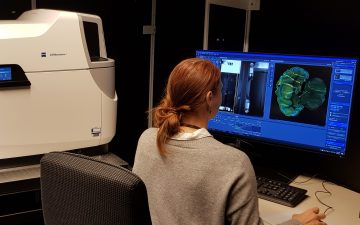RESEARCH CONDITIONS. After national and international evaluations, Proteomics and the Center for Cellular Imaging (CCI) at Sahlgrenska Academy’s Core Facilities are now set to be part of SciLifeLab. The units will join the SciLifeLab platforms Clinical Proteomics and Immunology and Cellular and Molecular Imaging.

“It is our teams’ hard and long-term work that has made this possible, and we are very happy that we now will fit within the framework of SciLifeLab with these specialized parts of our facilities,” says Elisabet Carlsohn who is head of department at Core Facilities.
Another Core Facilities unit, Clinical Genomics Gothenburg, has been connected to the SciLifeLab platform Clinical Genomics since before.
Enabling New Investments
In total, Core Facilities will receive just over SEK 6 million per year from SciLifeLab.
“Together with the university’s co-financing, this enables new investments in both advanced instrumentation and expertise,” Elisabet says.

At SciLifeLab, CCI will develop and provide support in 3D Correlative Array Tomography (3D CAT). Proteomics will provide increased support in clinical glycoproteomics.
The focus for Clinical Genomics Gothenburg will continue to be to enable translational research and implementation of high-throughput (HTP) techniques such as next-generation sequencing (NGS) for clinical use.
The Core Facilities units will also receive funding for expertise in Cryo-EM, where SciLifeLab supports a national network to expand accessibility to so-called screening activities.
First National SciLifeLab Nodes
For the coming grant period, another news is that SciLifeLab will establish national coordination nodes across Sweden, starting at the universities of Gothenburg and Lund. The local node for GU will be located within Core Facilities.
“The local node will give researchers at GU and also VGR increased access to SciLifeLab’s infrastructures, grants and programs,” says head of department at Core Facilities, Elisabet Carlsohn.
With the help of a dedicated project manager and communicator, researchers will be guided within SciLifeLab’s many capabilities.
“The goal is to increase the utilization of our existing national infrastructures, and at the same time GU’s capabilities will also be more visible,” Elisabet says.
The new node will also function as a direct channel to create transparent and flexible communication between the organizations.
At its most recent meeting, SciLifeLab’s board decided to allocate SEK 1 million per node and year for setting up and managing the nodes at the two universities.
BY: CHARBEL SADER










